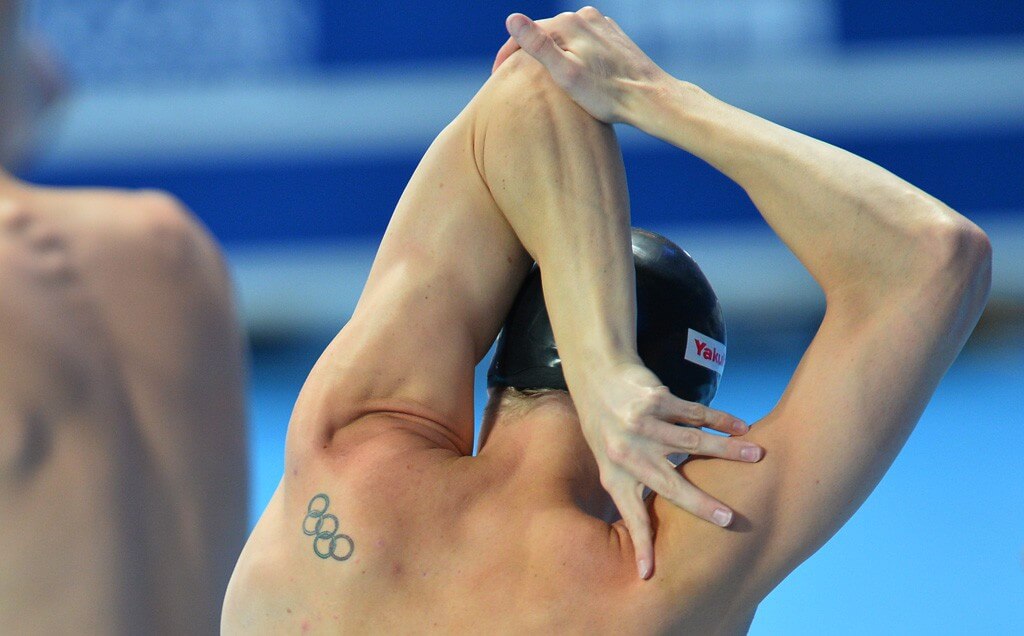Swimming Injuries: Beyond the Physical Impact

By: Ashley Illenye, Swimming World College Intern.
Being a student-athlete on any level is very demanding, especially as a swimmer. With three-day meets, 5 a.m. practices, and sleeping and eating habits you have to maintain, there is no question as to how swimming is time-consuming. What happens, however, when you have to take a swimmer out of the pool?
Injuries on all parts of the body are a negative part of sports that go along with being an athlete. The American Academy of Orthopedic Surgeons did a study where they found that up to 91 percent of swimmers suffer from shoulder pain. This is problematic because 90 percent of a swimmer’s movement through the water is upper body-based. Emotionally getting injured is very different than ending your swimming career on your own terms or at the end of a 10-15 year run.
Tendinitis in the knees, wrists, elbows, and shoulders can lead to season or potentially career ending injuries. There are also smaller restrictions that may be frustrating which are usually temporary such as concussions, spraining an ankle or any variation of agitated/tight muscles.
Swimming injuries are common but often may be missed, not taken seriously or misdiagnosed. As opposed to sports like football or lacrosse where you can identify most impact injuries immediately, injuries in swimmers are quiet. They sneak up on you as the result of years of intense training then may be mistaken for general soreness.
According to Stop Sports Injuries, the most common injury in swimming is the “Swimmer’s Shoulder.” This is the impingement of the bones into muscle due to inflammation in the rotator cuff which extends to the scapula and shoulder blade. Other than this, tendon issues in the knees (especially in breaststrokers) and lower back disc disjunction are common swimming injuries.
Any of these injuries may pull swimmers out of the water or require them to modify practices on a daily basis. Watching practices instead of participating in them may make swimmers anxious to get back into training too early. Not swimming for an athlete that loves the sport can seem as difficult as maintaining up to 30 training hours a week.
For an age group swimmer, an injury means not having their release at the end of a long day at school. For a high school or club swimmer, it could mean missing a championship meet along with valuable times for colleges to recruit you with. In college, an injury could lead to a narrow dual meet defeat or missing the opportunity to represent your team at your conference championships.
Swimming injuries aren’t just physical. They have a negative mental effect as well. Particularly when you’re in college, swimming has a strong hold on many parts of your life. This includes where your closest friends are, why you chose to go to that college, and how much financial aid you receive.
The NCAA did a study evaluating the mental impact of injuries on athletes. Some of the side effects include isolation, anger, lack of motivation, trouble sleeping, disengagement, and frustration. These feelings can potentially lead to more serious mental disorders such as anxiety, depression, and eating disorders. These effects turn the sport from being swimmer’s fight against these symptoms to the catalyst of them. Athletes are encouraged to seek help if any of the above effects occur in themselves or teammates.
So, how do we prevent swimming injuries?
There is little point in discussing injury without providing measures to prevent them. The technique of swimmers is the first place to look at. Dropping the elbow and over rotation are indicators of poor freestyle technique. Intense spikes in training should be carefully monitored as well.
There are exercises that can stabilize the shoulder to prevent swimming injuries.
- Use stretch bands for an internal/external exercise to stabilize the rotator cuff. For internal rotation, start with your arm positioned in front while your elbow rests on your side and pull in towards your belly button. Turn to the other side of the band and complete the movements from the belly button outward for the external effect.
- TYI exercises strengthen the scapular shoulder regions. Lay on your stomach and lift your arms 4-6 inches creating a T, Y, and I position with your arms.
- “Monster Walks” establish control in the rotator cuff. With the side of your forearm against the wall and a band wrapped around your wrists, slowly walk up as far up the wall as your reach allows then down to a 90-degree angle.
- “Field Goals” create a similar strength to monster walks. Stand with your back toward the wall. With the top of your hands against the wall slowly slide your arms up so they are straight and back down to the 90-degree angle.
All exercises should be completed in two sets of 15 or three sets of 10. In any case where an athlete performs these exercises, a professional should be present to give guided instruction. In addition to these exercises, swimmers should consider controlled active stretching before workout and icing and foam rolling after.
Swimmers should also be aware there is a difference between soreness and injury. If at any point, the soreness swimmers experience is sharp or doesn’t go away after icing and resting, this is a warning sign to start taking preventative measures. If a swimmer is experiencing any type of exceptional pain they should immediately contact their coach or any sort of qualified professional. Identifying potentially swimming injuries early can prevent athletes from having to end their season or career early.
All commentaries are the opinion of the author and do not necessarily reflect the views of Swimming World Magazine nor its staff. All swimming and dryland training and instruction should be performed under the supervision of a qualified coach or instructor, and in circumstances that ensure the safety of participants.



